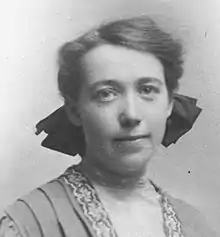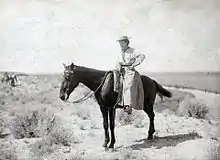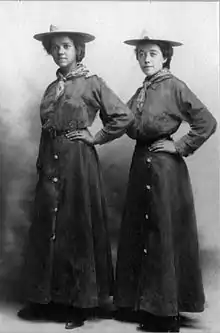Minerva Teichert
Minerva Bernetta Kohlhepp Teichert (August 28, 1888 – May 3, 1976) was a 20th-century American painter notable for her art depicting Western and Mormon subjects, including a collection of murals depicting scenes from the Book of Mormon.[1] Teichert is known for her religious themed paintings including Christ in a Red Robe, Queen Esther, and Rescue of the Lost Lamb. Additionally, Teichert painted 42 murals related to stories in the Book of Mormon that reside in the Brigham Young University Museum of Art.
Minerva Teichert | |
|---|---|
 Teichert in 1908 | |
| Born | August 28, 1888 |
| Died | May 3, 1976 (aged 87) |
| Nationality | American |
| Education | Art Institute of Chicago, Art Students League of New York |
| Known for | Western Art, Mormon Art |
Notable work | Christ in a Red Robe, Queen Esther, and Return of Captive Israel |
Early life

Minerva Teichert was born on August 28, 1888 in Ogden, Utah Territory.[2] She was the second of ten children born to Frederick John Kohlhepp, a railroad worker and rancher, and Mary Ella Hickman, a suffragette and pamphleteer.[3]:33, 180 Teichert grew up on a ranch in Idaho, taking advantage of her upbringing by sketching horses and ranch life from a young age.[4][3]:26 Her mother gave her her first set of watercolors when she was just four years old. For entertainment, she acted out plays and helped her father work on the farm.[2] She enjoyed riding her horse, exploring and sketching scenes from nature.[5] Both of her parents supported her creativity and imagination.[3]:180 She was named after her maternal grandmother, Minerva Wade Hickman, who was one of the wives of frontier lawman and express rider "Wild Bill" Hickman, and also a descendant of Colonial Governor Thomas Roberts of New Hampshire.[3]:180
Teichert's mother was an educated woman, who attended the Sacred Heart Academy in Ogden, Utah, instructed in language, arts, and music.[3]:33 She was of English, Scottish, Irish, Welsh, French, Belgian, Spanish and German ancestry. Teichert's father had come from a wealthy German-immigrant Jewish family in Boston, Massachusetts. He moved West as a young man in 1878. He hunted bison and bear, and worked on ranches near Buffalo, Wyoming and in the Powder River area. He drifted into Utah through Brown's Hole and the Uintah Basin, finally making it to the mining town of Stockton, Utah, southwest of the Salt Lake Valley. He was baptized into The Church of Jesus Christ of Latter-day Saints (LDS Church) in 1886.[3]:180 Fred and Mary married in 1887, and moved to Pocatello, Idaho a few years later.[3]:33 Fred had suffered an eye injury while working in the railroad yards which required the family to move frequently to various rural communities where they would open and run small shops.[3]:180 Due to the lack of schools in the area, Teichert and her siblings were frequently homeschooled, therefore Teichert did not receive a formal primary education.[3]:33
She left Idaho at age 14 to be a nursemaid in San Francisco. It was in San Francisco that she saw an art museum for the first time. She also took some classes at Mark Hopkins Art School.[2] She returned home, and after graduating from Pocatello High School,[6] she taught in Idaho to earn money to travel out east.[4]
Chicago and New York education
Minerva Teichert studied at the Art Institute of Chicago under John Vanderpoel.[2] While in Chicago, she became known as "Miss Idaho."[5] She finished her courses in 1912 and returned to Indian Warm Springs, Idaho to earn more money. During this time, she was courted by two young men. She also met her future husband, Herman Teichert. She left Herman and Idaho to pursue art.[2] She then studied at the Art Students League of New York in 1914, where she studied under Robert Henri, George Bridgman, and Dimitri Romanoffski.[4] Henri gave Minerva a scholarship and ranked her among his best three students. Minerva earned money for school by sketching cadavers for medical schools.[2] She also illustrated children's books and performed rope tricks and Indian dances. She was known for a headband that she wore throughout her life, which may have come from these performances.[7] Teichert was offered a scholarship to study in London, but instead returned home to get married.[8]:9
In 1917, she returned to Idaho. On September 15, 1917, she married Herman Adolph Teichert. After their marriage, he left to fight in World War I. The couple had five children. Minerva spent most of her life on a ranch in Cokeville, Wyoming while painting the things she knew and loved best: scenes from western Americana, and religious artwork expressing her deeply held convictions.[4] During her early years of marriage, she sketched on scraps of wood and paper because there wasn't enough money to buy art supplies.[2]
Career

Minerva Teichert painted throughout her life. She painted in her living room; while working on murals she folded her canvas and used the large end of a pair of binoculars to look at her work in perspective.[9] She once explained "I must paint", when asked about how she persisted in painting despite being in near-complete artistic isolation, without a dedicated studio or even much free time to create. Teichert was an independent, opinionated woman who stood up for women's rights and was an outspoken political conservative. She shared her talents with others and gave art lessons out of her home.[2] In addition to her art career, she raised five children and took care of her homestead and ranch.[10]
In 1947, Teichert won first prize in the LDS Church centennial art contest and was the first woman to paint an LDS temple mural.[5] In the mid-1940s, having achieved success painting murals, Teichert began painting a series of murals related to stories from the Book of Mormon.[11]:10 She originally considered making plays on the subject of the Book of Mormon, but instead made paintings. She used live models, costumes based on sketches she had done while traveling in Mexico, and painted backdrops.[11]:10 She gained inspiration through scholarly writers such as Hugh Nibley.[11]:11 Teichert painted over forty Book of Mormon murals.[11]:11 In the mid-1950s, she put the murals on slides for presentations. Despite wanting to put the murals in book form, this would not happen in her lifetime.[11]:12
Style and works
Women and western themes feature prominently in Teichert's works, such as The Madonna of 1847, which depicts a mother and child in a covered wagon, crossing the plains to settle in Utah.[3]:5, 52–53 While Teichert painted over 400 murals,[12] she is known for a set of 42 murals from the Book of Mormon, as well as her murals inside the Manti Utah Temple.[12] She also painted murals for the church's tabernacle in Montpelier, Idaho, but unfortunately, they were removed to make space for a heating system.[9] Teichert's distinctive style can be seen in the painting Christ in the Red Robe, in which women can be seen reaching out to Christ. He is depicted in a red robe at his second coming, referencing Isaiah. The colors are mostly subdued, except for the central figure who is brightly illustrated.[12]
Teichert painted much of the clothing in her paintings with patterns, a detail unique to her paintings. She would also include the color red to add contrast. She often left the edges unfinished or just sketched.[7] Many of her paintings are filled with the colors from the desert and feature distant mountains.[9] Teichert submitted many pieces of artwork to the church; however, during her lifetime, many of them were rejected.[7] She gave several paintings to Brigham Young University to pay tuition for members of her family.[2] Her works are prolifically displayed around the campus of Brigham Young University. Several of her paintings can be seen in the Joseph Smith Building, the Wilkinson Student Center, and the Museum of Art. One of Teichert's most famous exhibits, "Pageants in Paint", has been on display in the Museum of Art.[13] Several of Teichert's works are also on display on the campus of Brigham Young University–Idaho.[6] Teichert's Book of Mormon murals are part of the collection at the Brigham Young University Museum of Art.[14]
Church service
Minerva Teichert was a member of The Church of Jesus Christ of Latter-day Saints. Her faith impacted the subjects of much of her work. She was the first woman sent on an art mission by the church to Chicago and then to New York City[12] before she attended the Art Students League.[7] She served in various responsibilities in the church, including Primary President. and on the Stake Sunday School Board. She also worked with the Young Women organization.[2]
Her husband, Herman, was not a member of the church when the couple was married. He supported her activity in the church and donated tithing. He was later baptized in 1933. The couple was sealed the following year in the Logan Utah Temple.[2] Minerva Teichert and her husband Herman had five children.[3]:185–186
Teichert continued painting into her seventies. Due to a hip fracture from a fall in 1970, she had to stop painting.[7][3]:195 She entered a nursing home in 1973 and died in Provo, Utah, on May 3, 1976.[2][3]:195 She was buried in the Cokeville, Wyoming cemetery.[3]:195
Legacy
During Minerva Teichert's lengthy career, she is believed to have painted thousands of paintings.[3]:vi The Utah Museum of Fine Arts in Salt Lake City, Utah, currently owns two works by Teichert: "Battle of the Bulls", dated circa 1946, and "Market Girl," circa 1912.[15] "Pioneers: Water Scene," from 1936, is in the collection of the Brigham City Museum.[16] Along with other renowned American artists of the twentieth-century, Teichert's work was featured in the semi-permanent exhibition "Becoming America" at the Brigham Young University Museum of Art from 2019 to 2022.[17][18]
See also
References
- Cannon, Elaine (2000). "Teichert, Minerva". In Arnold K. Garr; Donald Q. Cannon; Richard O. Cowan (eds.). Encyclopedia of Latter-day Saint History. Salt Lake City, Utah: Deseret Book. ISBN 1573458228.
- Jay Underwood Pinborough (1989-04-01). "Minerva Kohlhepp Teichert: With a Bold Brush". Ensign.
- Wardle, Marian (2007). Minerva Teichert: Pageants in Paint. Provo, UT: Brigham Young University Museum of Art. ISBN 9780842526821.
- Finding aid authors: John M. Murphy, Sally McDonald, Lindsey Christensen, Julie Slater, and Elizabeth Ballif (2013). "Minerva Kohlhepp Teichert personal and professional papers". Prepared for the L. Tom Perry Special Collections, Provo, UT. Retrieved May 10, 2016.
- Gardner, Peter B. (Winter 2008). "Painting the Mormon Story". BYU Magazine. Retrieved 10 May 2016.
- "Historic Minerva Teichert paintings on display in Ricks religion building". Deseret News. 1 Feb 2001. Retrieved 10 May 2016.
- "Minerva Teichert". LDS Women of God. 14 Dec 2010. Retrieved 10 May 2016.
- Scharffs, Deirdre (2016). Refiguring the Wild West: Minerva Teichert and her Feminine Communities (thesis). Brigham Young University. Retrieved 19 May 2016.
- Black, Susan Easton; Woodger, Mary Jane (2011). Women of Character. American Fork, Utah: Covenant Communications, Inc. p. 328. ISBN 978-1-60861-212-3.
- Johnson, Marian (1990). "Minerva Teichert: Scriptorian and Artist". BYU Studies. 30 (3). Retrieved 19 May 2016.
- Welch, John W.; Dant, Doris R. (1997). The Book of Mormon Paintings of Minerva Teichert. Provo, Utah: BYU Studies. ISBN 1570083789.
- "Famous LDS Artist's Work on Display at BYU". KSL News. 2007-08-03.
- "Opening reception for "Minerva Teichert: Pageants in Paint" Sept. 26 at MOA". BYU News. 2007-09-19.
- "Minerva Teichert: Book of Mormon Highlights". Brigham Young University Museum of Art. Brigham Young University. Retrieved August 9, 2019.
- "Argus: UMFA Collection". Retrieved 18 April 2017.
- "Box Elder Museum Collections: Art: Pioneers: Water Scene [Hinc28]". Retrieved 18 April 2017.
- Brooks, Kylie. "Becoming America". Brigham Young University Museum of Art. Brigham Young University. Retrieved August 9, 2019.
- Harris, Sarah (May 30, 2019). "BYU museum spotlights American art in new semi-permanent exhibit". Daily Herald. Herald Communications. Retrieved August 9, 2019.
Further reading
- Oman, Richard G. (1992), "Artists, Visual", in Ludlow, Daniel H (ed.), Encyclopedia of Mormonism, New York: Macmillan Publishing, pp. 70–73, ISBN 0-02-879602-0, OCLC 24502140
- Wardle, Marian (1988). Minerva Teichert's Murals: The Motivation for her Large-Scale Production (thesis). Brigham Young University. Retrieved 19 May 2016.
External links
 Media related to Minerva Teichert at Wikimedia Commons
Media related to Minerva Teichert at Wikimedia Commons- Minerva Teichert art website
- Minerva Kohlhepp Teichert personal and professional papers, MSS 2243 at L. Tom Perry Special Collections, Brigham Young University
- Minerva Teichert's Book of Mormon Collection
- Antiques Roadshow Segment on PBS: 1959 Minerva Teichert "Cowboy with Sheep"